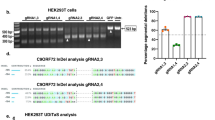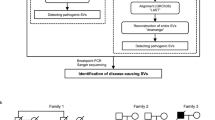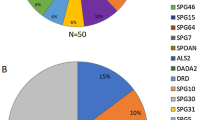Abstract
Objectives:
Hereditary spastic paraplegia (HSP) is a heterogeneous group of neurodegenerative disorders characterized by a progressive gait disorder, lower limb spasticity, hyper-reflexia, weakness and extensor plantar responses. Recently, large intronic hexanucleotide repeat expansions (GGGGCC) in C9ORF72 have been found to cause frontotemporal dementia (FTD), amyotrophic lateral sclerosis and FTD with motor neuron disease. Owing to the overlapping phenotypes among HSP, amyotrophic lateral sclerosis and FTD with motor neuron disease along with shared pathological findings, we hypothesized that C9ORF72 expansions might be a genetic risk factor or modifier of HSP.
Methods:
Clinically characterized HSP patients were investigated for elongations in the hexanucleotide repeat of C9ORF72.
Results:
Upon analyses of the repeat lengths in the C9ORF72 gene in a Danish cohort of HSP patients, we found no expansions.
Conclusion:
We conclude that HSP is most likely not associated with repeat expansions in C9ORF72.
Similar content being viewed by others
Log in or create a free account to read this content
Gain free access to this article, as well as selected content from this journal and more on nature.com
or
References
Erichsen AK, Koht J, Stray-Pedersen A, Abdelnoor M, Tallaksen CM . Prevalence of hereditary ataxia and spastic paraplegia in southeast Norway: a population-based study. Brain 2009; 132: 1577–1588.
Fink JK . Hereditary spastic paraplegia: clinico-pathologic features and emerging molecular mechanisms. Acta Neuropathol 2013; 126: 307–328.
Blackstone C, O'Kane CJ, Reid E . Hereditary spastic paraplegias: membrane traffic and the motor pathway. Nat Rev Neurosci 2011; 12: 31–42.
DeJesus-Hernandez M, Mackenzie IR, Boeve BF, Boxer AL, Baker M, Rutherford NJ et al. Expanded GGGGCC hexanucleotide repeat in noncoding region of C9ORF72 causes chromosome 9p-linked FTD and ALS. Neuron 2011; 72: 245–256.
Renton AE, Majounie E, Waite A, Simon-Sanchez J, Rollinson S, Gibbs JR et al. A hexanucleotide repeat expansion in C9ORF72 is the cause of chromosome 9p21-linked ALS-FTD. Neuron 2011; 72: 257–268.
Murray ME, DeJesus-Hernandez M, Rutherford NJ, Baker M, Duara R, Graff-Radford NR et al. Clinical and neuropathologic heterogeneity of c9FTD/ALS associated with hexanucleotide repeat expansion in C9ORF72. Acta Neuropathol 2011; 122: 673–690.
Neumann M, Kwong LK, Sampathu DM, Trojanowski JQ, Lee VM . TDP-43 proteinopathy in frontotemporal lobar degeneration and amyotrophic lateral sclerosis: protein misfolding diseases without amyloidosis. Arch Neurol 2007; 64: 1388–1394.
Martinez-Lage M, Molina-Porcel L, Falcone D, McCluskey L, Lee VM, Van Deerlin VM et al. TDP-43 pathology in a case of hereditary spastic paraplegia with a NIPA1/SPG6 mutation. Acta Neuropathol 2012; 124: 285–291.
Neumann M, Sampathu DM, Kwong LK, Truax AC, Micsenyi MC, Chou TT et al. Ubiquitinated TDP-43 in frontotemporal lobar degeneration and amyotrophic lateral sclerosis. Science 2006; 314: 130–133.
Scheuer KH, Nielsen JE, Krabbe K, Simonsen C, Koefoed P, Sorensen SA et al. Reduced regional cerebral blood flow in SPG4-linked hereditary spastic paraplegia. J Neurol Sci 2005; 235: 23–32.
Satoh JI, Tabunoki H, Ishida T, Saito Y, Arima K . Dystrophic neurites express C9ORF72 in Alzheimer's disease brains. Alzheimers Res Ther 2012; 4: 33.
Majounie E, Abramzon Y, Renton AE, Perry R, Bassett SS, Pletnikova O et al. Repeat expansion in C9ORF72 in Alzheimer's disease. N Engl J Med 2012; 366: 283–284.
Fink JK, Heiman-Patterson T, Bird T, Cambi F, Dube MP, Figlewicz DA et al. Hereditary spastic paraplegia: advances in genetic research. Hereditary spastic paraplegia working group. Neurology 1996; 46: 1507–1514.
Lindquist S, Duno M, Batbayli M, Puschmann A, Braendgaard H, Mardosiene S et al. Corticobasal and ataxia syndromes widen the spectrum of C9ORF72 hexanucleotide expansion disease. Clin Genet 2012; 23: 279–283.
Elden AC, Kim HJ, Hart MP, Chen-Plotkin AS, Johnson BS, Fang X et al. Ataxin-2 intermediate-length polyglutamine expansions are associated with increased risk for ALS. Nature 2010; 466: 1069–1075.
Nielsen TT, Svenstrup K, Budtz-Jorgensen E, Eiberg H, Hasholt L, Nielsen JE . ATXN2 with intermediate-length CAG/CAA repeats does not seem to be a risk factor in hereditary spastic paraplegia. J Neurol Sci 2012, 100–102.
Polymenidou M, Lagier-Tourenne C, Hutt KR, Bennett CF, Cleveland DW, Yeo GW . Processing in amyotrophic lateral sclerosis. Brain Res 2012; 1462: 3–15.
Harms MB, Neumann D, Benitez BA, Cooper B, Carrell D, Racette BA et al. Parkinson disease is not associated with C9ORF72 repeat expansions. Neurobiol Aging 2012; 34: 1519.e1–2.
Acknowledgements
The study was supported by the Bevica Foundation, the Aase og Ejnar Danielsen Foundation, the Dagmar Marshall Foundation, Vanførefonden and the Novo Nordisk Foundation.
Author information
Authors and Affiliations
Corresponding author
Ethics declarations
Competing interests
The authors declare no conflict of interest.
Rights and permissions
About this article
Cite this article
Nielsen, T., Svenstrup, K., Duno, M. et al. Hereditary spastic paraplegia is not associated with C9ORF72 repeat expansions in a Danish cohort. Spinal Cord 52, 77–79 (2014). https://doi.org/10.1038/sc.2013.116
Received:
Revised:
Accepted:
Published:
Issue date:
DOI: https://doi.org/10.1038/sc.2013.116
Keywords
This article is cited by
-
The Spectrum of C9orf72-mediated Neurodegeneration and Amyotrophic Lateral Sclerosis
Neurotherapeutics (2015)



